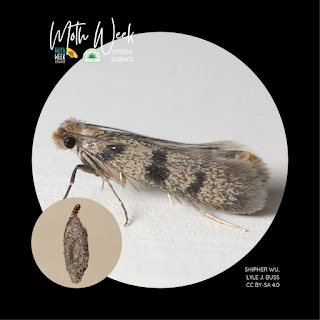National Moth Week 2023 - The Household Casebearer Moth
The household casebearer moth, scientifically known as Phereoeca uterella, belongs to the family Tineidae. A very familiar moth, it is commonly found in households in warm, humid areas. The juvenile caterpillar life stage of this moth resembles a worm-like insect hiding and protected within a flat, gray case.
The larvae form a distinctive silk case around themselves for protection and camouflage. The main food source for this species appears to be silk, especially spider webs, but also silk produced by other arthropods including discarded cases from the same species.
Larvae also feed on dander and fallen human hair. Wool (but not cotton) is a favored food and the species can be a household pest due to its food sources found indoors. Routine vacuuming and cleaning, utilization of hanging moth traps (glue traps that use pheromones to attract and trap male moths), as well as natural remedies such as a bag filled with fresh garlic cloves near the infested area are known to reduce moth incidences. The author prefers the use of a few drops of lavender oil misted in his closet occasionally to deter them.
Females can produce up to 200 light-blue eggs. Both partners die after mating. The eggs take approximately 10 days or more to hatch. The larvae undergo six or seven instars that require about 50 days to mature. The pupa stage lasts between, on average, 11 to 23 days. A complete cycle from egg to adult takes about two and a half months
As for the well-known case of this moth, it begins with the earliest instar- with each instar, a larger case. The case is created by the secretion of silk into an arch shape, anchored on both ends by a substrate. The arch gradually is extended to form a tunnel, exclusively made of the moth silk from the larvae building it on the inside. The tunnel is then enclosed from the substrate, thereby producing a tube free from attachment and with openings on both ends. The outside of the case, on the other hand, uses various materials ranging from fibers, hair, dirt, and other organic and inorganic materials found nearby.
As the larva continues through instars, the case broadens since the larva uses both ends of the case to turn around and emerge from either opening. The case is remarkably tough and durable, providing protection to its host. The larva have three pairs of well-developed legs that allow mobility. The pupa stage begins when the larva starts to climb a vertical surface. The case is affixed to the surface with silk and the larva cuts slits on both sides to make the case flatter- it is this stage that is very familiar to observers due to its bowed-shaped casing.
After eclosing, adults do not feed and are known to rest on the webs of cobweb spiders ( Theridiid species ). Females have a wingspan of 7-13 millimeters with males being slightly smaller.
Come celebrate moth awareness week collaboratively with National Moth Week and Florida Native Plant Society. Like and share your own experiences with us.
Caterpillar image courtesy of University of Florida, Lyle J. Buss
Adult image courtesy of Shipher Wu
Caption provided by FNPS President, Mark Kateli
Instagram: @markkateli | Facebook: Mark Kateli




Comments